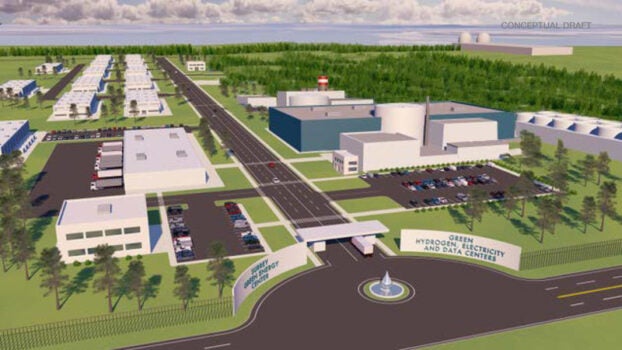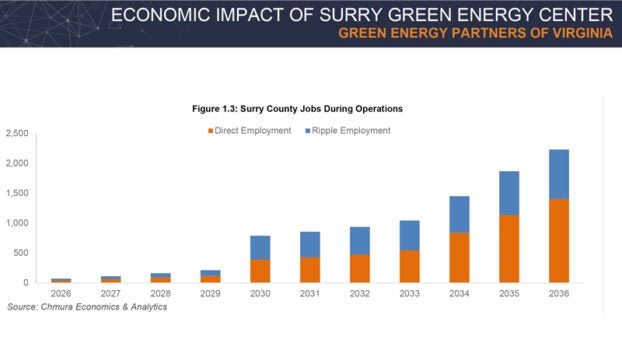Surry approves nuclear-powered data center campus that promises more than 1,300 jobs
Published 6:48 pm Monday, February 12, 2024
Surry County supervisors voted 3-2 on Feb. 8 to approve rezoning for the first-in-the-nation combination data center and hydrogen fuel hub Green Energy Partners plans to build adjacent to Dominion Energy’s nuclear power plant.
Supervisors Amy Drewry and Timothy Calhoun, who urged their fellow board members to delay a decision, cast dissenting votes.
The Middleburg-based company announced last year it had acquired the roughly 600-acre tract of land following a multiyear search across the East Coast for prospective sites. Greg Davis, an attorney representing Green Energy, said the $6.45 billion investment in Surry over a 13-year buildout will by 2036 bring more than 1,300 permanent jobs, half with six-figure salaries, to the largely rural county of 6,500 residents.
Green Energy’s announcement last year estimated 2,000 to 3,000 jobs, though company and county officials each later acknowledged that not all would be permanent, nor would the influx occur all at once. Most of the permanent positions, according to an economic impact analysis submitted with Green Energy’s rezoning application, would be tied either to the hydrogen plant or the operation of the three small, modular nuclear reactors, or SMRs, Green Energy is proposing to power the data centers on site.
Northern Virginia, where many of the state’s more than 300 data centers are currently housed, is, according to Davis, running out of the high-voltage transmission capacity needed to power the electricity-hogging computer infrastructure that runs 24-7 internet-based services. The shortage has spurred some developers, including Green Energy, to seek out more rural localities like Surry, which completed a fiber-optic high-speed internet infrastructure buildout in 2022. In Louisa County, another rural locality just over 100 miles northwest of Surry, Amazon is planning to invest $11 billion to build two data center campuses by 2040 adjacent to Dominion’s sister nuclear plant at Lake Anna.
Data centers, even if powered by carbon-free energy sources like nuclear, still need backup generators that rely on diesel fuel. Hydrogen “would remove even that carbon use from the footprint,” Davis said.
Green Energy is proposing 19 data centers spread across a 3 million-square-foot campus. The population influx and $74 million in annual tax revenue by 2036, which is more than double the $27 million Surry expects to take in this year, has the potential to stem or even reverse Surry’s decades-long population decline and lower-than-median household incomes. According to census data, Surry household incomes were 21% below the state median as of 2020.
“The rezoning passage by the Surry Board last Thursday was a huge win for the community and the Green Energy Surry Center project,” said Bill Puckett, Green Energy’s chief operating officer.
But the first-of-its-kind project isn’t without controversy, some of which is centered around the prototype SMRs.
“This is not a technology that’s available as I stand here tonight,” Davis said of the reactors. “These are the small reactors that have been used since the 1950s on submarines and naval vessels without any sort of incident, and they’re under study and development for terrestrial use, but we’re seven or 10 years away from that.”
Mike Eggleston, one of eight speakers in opposition, called SMRs an “unproven technology” and made reference to the 1979 partial nuclear meltdown at Three Mile Island plant 11 miles outside Pennsylvania’s capital city, Harrisburg. According to a report by the federal Nuclear Regulatory Commission, the incident remains the most serious involving a commercial nuclear plant on U.S. soil and spurred sweeping changes in nuclear operating safety, though “its small radioactive releases had no detectible health effects on plant workers or the public.”
Puckett, in 2023, said the proposed SMRs would likely use tristructural isotropic, or “TRISO” fuel, which encases nuclear material in titanium and other materials to create golf-ball-sized pellets. According to the U.S. Department of Energy’s website, “TRISO particles cannot melt in a reactor and can withstand extreme temperatures that are well beyond the threshold of current nuclear fuels.”
Another speaker, Daniel Shaye, called Green Energy’s proposal an “invasion by corporate interests,” one that “our rural, quiet, peaceful way of life will not withstand.” Three other speakers said they supported the project.
Prior to the approval vote, Drewry had made a motion to table the matter, calling Green Energy’s proffered conditions, which include $950,000 in improvements to Hog Island Road, “vague.”
“We have time to do this; it’s not that I’m against the project,” Drewry said, raising the question of who would pay should the cost of the proposed turn lanes and road signage increase beyond the current $950,000 estimate. Calhoun seconded Drewry’s motion, which drew only her own and Calhoun’s votes.
According to a traffic study included in Green Energy’s rezoning application, the combined impact of the data centers, SMRs and hydrogen fuel plant would nearly double the 1,900 average daily weekday vehicular trips the Virginia Department of Transportation reported in 2021, increasing the number by 93% to over 3,600.
Supervisor Walter Hardy, who argued the project would provide high-paying local jobs and potential to lower the county’s tax rate, made a motion to approve the rezoning, which Supervisor Breyon Pierce seconded. Pierce then made a motion to approve the related comprehensive plan land use map amendment Green Energy had requested, which Hardy seconded. Each motion passed 3-2 with Calhoun and Drewry voting no.







